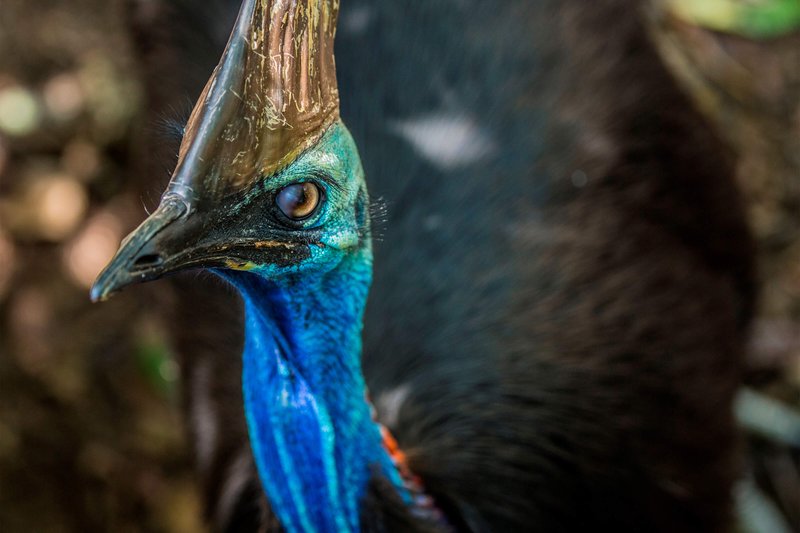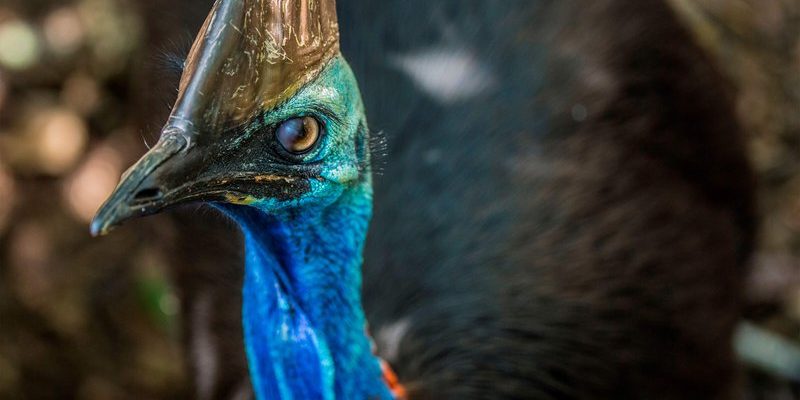
When you think about the cassowary, picture this: a bird that can sprint through dense jungle undergrowth and jump almost 5 feet high with astonishing grace. Yet, it is also known as one of the world’s most dangerous birds due to its powerful legs and sharp claws. So, let’s embark on a journey to learn more about this extraordinary creature—the cassowary.
Overview of the Cassowary
The cassowary belongs to the family Casuariidae, which includes three species: the Southern cassowary, the Northern cassowary, and the Gympie or cassowary. What’s striking about these birds is their large size; the Southern cassowary can weigh up to 130 pounds. They are flightless birds, which sets them apart from many other avian species. Instead of soaring the skies, cassowaries are masters of the rainforest floor, navigating complex habitats with ease.
In terms of physical appearance, cassowaries feature a unique combination of colors. Their glossy feathers range from deep blue to black, with the most eye-catching part being the vibrant yellow and red wattles that hang from their necks. But the most recognizable feature is undoubtedly their casque—a helmet-like structure on their heads. This casque could serve multiple purposes, including protection and even communication among the species.
Interestingly, cassowaries play a crucial role in their ecosystem. They are known as “keystone species” because they help maintain their habitat by dispersing seeds from the fruits they eat. This activity allows various plant species to thrive, making cassowaries vital for forest regeneration.
Habitat and Distribution
So, where can you find these magnificent birds? Cassowaries primarily inhabit tropical rainforests, swamp forests, and lowland forests. They thrive in the warm, humid climates of New Guinea, parts of Indonesia, and northeastern Australia. The lush environments provide plenty of food and shelter, which is essential for their survival.
You might wonder about their living conditions. Cassowaries like areas that are dense and have plenty of underbrush. This allows them to hide from predators and feel secure. They often make use of the forest floor, where they scratch at the ground to find edible plants, fruits, and insects. Their impressive legs, built for speed and strength, help them run up to 30 miles per hour through dense vegetation, making them elusive despite their size.
Interestingly, cassowaries are solitary creatures. Unlike some birds that thrive in flocks, they prefer to roam alone or in small groups. This behavior allows them to establish and maintain their territory without the competition of other cassowaries. However, during the mating season, they may come together briefly to mate, after which they go their separate ways again.
Diet and Feeding Habits
What do cassowaries eat? They are omnivorous, meaning their diet consists of both plants and animals. Their primary food source includes fruits, seeds, and fungi. Cassowaries are particularly fond of fallen fruits, like the native fruits of the rainforests, and can consume large quantities. They have a strong digestive system that helps them break down tough seeds. In fact, some seeds can pass through their digestive tract unharmed, allowing them to sprout in new locations.
They also munch on small animals, insects, and various fungi. In areas where they live, you might see them scratching the forest floor for insects or digging into the underbrush for hidden treasures. It’s fascinating to think that while they are primarily fruit-eaters, they play an essential role in maintaining the ecosystem through their varied diet.
One unique aspect of cassowary feeding is how they interact with trees. They have a strong preference for specific fruits, and their eating habits can affect the growth of certain trees, as they help in seed dispersal. This relationship highlights the importance of cassowaries in their environment—they are not just passive consumers but active participants in shaping the forest.
Behavior and Social Structure
When it comes to behavior, cassowaries are known for their curious and sometimes temperamental personalities. They are generally shy and avoid human contact, preferring their solitude. However, if threatened, they can become aggressive, showcasing their famous defensive traits. With powerful legs and sharp claws—capable of inflicting serious injuries—they certainly have a reputation to uphold.
One of the more intriguing aspects of cassowary behavior is their vocalizations. While they may appear silent, they use a range of sounds to communicate, including booming calls that can travel over long distances. The sounds serve as both a means of attracting mates during the breeding season and warning off potential rivals. This vocal prowess adds an element of mystery to their elusive nature.
When it comes to reproduction, cassowaries follow a fascinating cycle. Mating usually occurs during the wet season, when food is abundant. The female lays a clutch of 3–5 eggs, which the male then incubates for about 50 days. Once the chicks hatch, they are precocial, meaning they can walk and feed themselves almost immediately. However, they rely on their father for protection and guidance during their early days.
Threats and Conservation Status
Like many wildlife species, cassowaries face several threats that could impact their populations. One of the primary concerns is habitat destruction due to logging, agriculture, and urban development. As their forest homes shrink, cassowaries find it increasingly difficult to find food and shelter, leading to population declines.
Another significant threat is vehicle collisions. Their natural instinct to cross roads can lead them into dangerous situations, as many cassowaries have been killed on highways. Conservationists are working to mitigate these risks, but raising awareness among the public is essential.
Despite these challenges, efforts are underway to protect cassowaries and their habitats. Various national parks and reserves have been established to safeguard these birds and promote their conservation. Education programs aiming to inform local communities about the importance of cassowaries and their role in the ecosystem are also crucial in ensuring their survival.
To give you a clearer idea of cassowaries and their significance, here’s a quick overview in table format:
| Common Name: | Cassowary |
| Scientific Name: | Casuarius |
| Height: | Up to 6 feet |
| Weight: | Up to 130 pounds |
| Habitat: | Tropical rainforests |
| Diet: | Fruits, seeds, insects |
| Lifespan: | Up to 40 years in the wild |
| Conservation Status: | Vulnerable |
Interesting Facts About Cassowaries
Now that we’ve covered the basics, let’s highlight some fun and fascinating facts about cassowaries. First off, did you know that they are often referred to as the “world’s most dangerous bird”? This title doesn’t come lightly; their powerful legs can deliver a kick that can be lethal to potential threats.
Moreover, cassowaries are excellent swimmers. Despite their hefty size, these birds can navigate waters with impressive skill. This ability helps them reach isolated forest areas and evade threats, showcasing their adaptability in survival.
Lastly, their casque, the bony structure on their heads, isn’t just for looks. Scientists believe it might help with sound amplification during their booming calls or even help them navigate through dense foliage. How cool is that?
FAQ
What is a cassowary’s primary habitat?
Cassowaries primarily inhabit tropical rainforests, swamp forests, and lowland forests. They prefer warm, humid climates where they can find abundant food and shelter. Their natural habitats are lush and dense, allowing them to thrive and evade predators.
Can cassowaries fly?
No, cassowaries are flightless birds. Despite their large size and impressive wings, they lack the ability to fly. Instead, they have adapted to live on the forest floor, where they run swiftly and navigate through dense vegetation.
How fast can a cassowary run?
Cassowaries can reach speeds of up to 30 miles per hour. Their strong legs and powerful muscles enable them to maneuver quickly through their forest habitats, making them agile despite their size.
Are cassowaries social birds?
Cassowaries are primarily solitary creatures. They prefer to live alone or in small groups, except during the breeding season when they come together to mate. After mating, they return to their solitary lifestyles.
How do cassowaries communicate?
Cassowaries use a variety of vocalizations to communicate. Their booming calls can be heard over long distances, serving both as mating calls and warnings to other cassowaries. These sounds add an intriguing layer to their behavior, allowing them to interact across their dense habitats.
What do baby cassowaries look like?
Baby cassowaries, also known as chicks, are covered in brown and white striped down feathers. This coloration helps them blend into their surroundings, protecting them from predators during their vulnerable early days. They can walk and feed themselves shortly after hatching but rely on their father for protection.
What is their conservation status?
Cassowaries are classified as a vulnerable species due to habitat loss and other threats. Conservation efforts are active in regions where they live to protect their populations and preserve their natural habitats. Awareness and education programs are also crucial in helping local communities understand the importance of these magnificent birds.
How long do cassowaries live?
In the wild, cassowaries can live up to 40 years. Their lifespan can vary based on environmental factors, threats, and their ability to locate food and shelter effectively. Conservation efforts aim to ensure that they thrive in their natural habitats throughout their lives.

